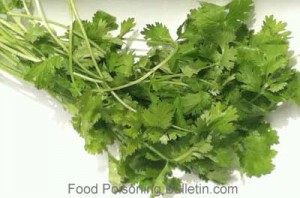 A 31-state cyclospora outbreak that sickened 546 was the second-largest multistate food poisoning outbreak of 2015. Some of the illnesses were linked to fresh cilantro imported from Puebla, Mexico. Other food sources were not identified.
A 31-state cyclospora outbreak that sickened 546 was the second-largest multistate food poisoning outbreak of 2015. Some of the illnesses were linked to fresh cilantro imported from Puebla, Mexico. Other food sources were not identified.
Cyclospora is a parasite that lives in subtropical climates. The hallmark of an infection, called cyclosporiasis, is profuse, often explosive, diarrhea that can last up to two months. Other cyclosporiasis symptoms, which can also last more than 60 days, include abdominal cramps, bloating, gas, nausea, fatigue, loss of appetite, weight loss, vomiting, body aches, low-grade fever, and other flu-like symptoms.
In 2014, cilantro from Puebla Mexico was also identified as the source of an outbreak that sickened at least 126 people in Texas. When investigators from the U.S. Food and Drug Administration (FDA) visited the implicated growing area, they found human waste and toilet paper in the cilantro fields. The FDA then placed an import alert on cilantro form that area. Although the alert essentially banned cilantro from area from being imported to the U.S., the product still made its way in and was marketed as being from another area, according to a lawsuit filed by produce wholesaler Farmers Friend.
The Centers for Disease Control and Prevention (CDC) broke down the case count for 319 of the 546 sickened after May 1 as follows: Arkansas (3), California (2), Connecticut (5), Florida (13), Georgia (26), Illinois (9), Iowa (1), Kansas (2), Maryland (1), Massachusetts (12), Michigan (2), Missouri (1), Montana (3), Nebraska (1), New Jersey (7), New Mexico (2), New York (excluding NYC) (10), New York City (22), North Carolina (1), Texas (179), Utah (1), Virginia (3), Washington (2), and Wisconsin (11). Case patients, who ranged in age from 15 to 89 years old, reported onset of illness dates ranging from May 1 to August 22, 2015.
It is difficult for consumers to protect themselves from this parasite as washing produce cannot remove all of it.




